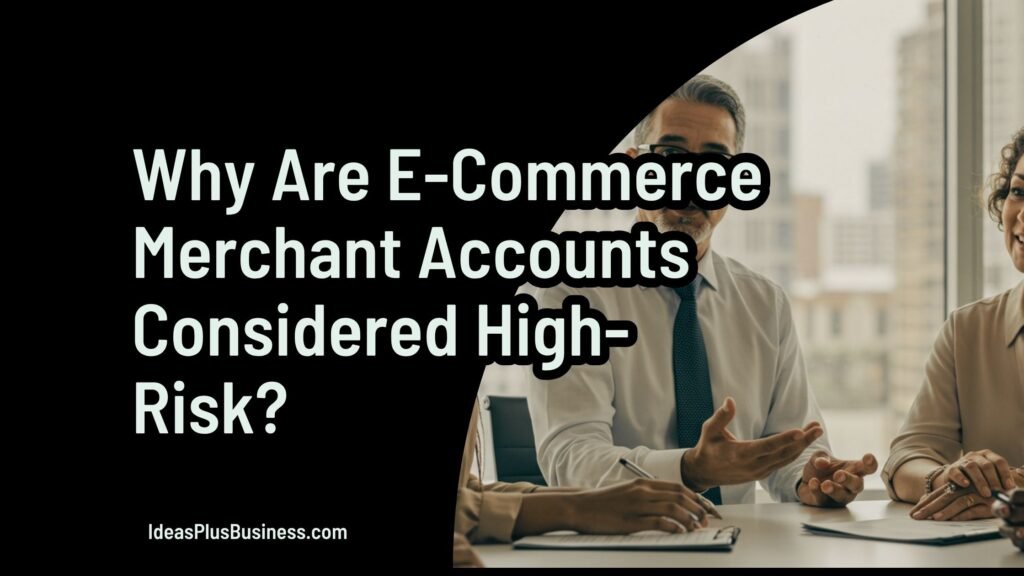Ecommerce is booming. More people shop online every year.
But, with this growth comes some hurdles for merchants. One of the biggest hurdles is getting an ecommerce merchant account. Not all merchant accounts are the same. Some are seen as high risk by payment providers.
But why are ecommerce merchant accounts considered high-risk?
In this article we will examine some of the reasons why ecommerce merchant accounts are high-risk, challenges faced by high-risk ecommerce merchants, and strategies ecommerce merchants can use to mitigate their high-risk status.
What Is a High-Risk Merchant Account?
A high-risk merchant account is like a special kind of business bank account. It’s built for companies that are considered more likely to face problems with payments.
Unlike standard accounts, these are assigned to merchants in tricky industries or with certain behaviors. They usually have higher fees and stricter rules.
Some sectors tend to get labeled high risk more often. Online gambling, adult content, health supplements, and subscription services are common examples. These areas are tightly regulated and face legal roadblocks.
Payment processors worry about legal issues or reputation damage when working with these merchants.
In recent years, more online fraud and chargebacks have made payment companies overly cautious. Sectors seeing a rise in scams or disputes face tougher screening. Data shows that industries like travel booking and online gaming are under closer watch.
This makes it harder for these merchants to find trustworthy payment options.
Why Are Ecommerce Merchant Accounts Considered High-Risk?
Here are some of the reasons why ecommerce merchant accounts are considered high-risk:
1. Industry-Specific Factors
Certain ecommerce fields generate a lot of chargebacks like returns, refunds, or disputes. Digital products or subscription boxes often see people requesting refunds quickly.
Some industries have higher fraud rates or face more legal hurdles. For example, health supplements can cause legal trouble if claims aren’t verified.
2. Transaction-Related Risks
Ecommerce businesses that process large volumes of transactions are viewed as risky. Bigger sales mean more chances for fraud or disputes.
Rapidly growing stores or those accepting many small transactions also raise red flags. Chargebacks hurt merchants and payment providers alike.
3. Legal and Regulatory Challenges
Online sellers must follow strict rules like PCI DSS for data security. Crossing borders adds tight legal DNA to mess with.
Different countries have different laws about selling certain products. Navigating these laws makes some businesses riskier to process payments for.
4. Payment Processing and Fraud Vulnerabilities
Cybercriminals often steal credit card info or use stolen identities to buy online. E-commerce sites are prime targets for hacking.
Payment processors worry about fraud that can lead to huge losses. They prefer to flag or deny high-risk merchants to protect themselves.
5. Business Model and Operational Factors
High refund and return rates make a business look unstable. Using many payment companies, or changing processors often, can also flag a merchant. These signs suggest instability, increasing the perception of risk.

Challenges Faced by High-Risk Ecommerce Merchants
Here are some challenges faced by high-risk ecommerce merchants:
1. Difficulties in Securing Merchant Accounts
Getting approval from payment processors isn’t easy. Many providers refuse to work with high-risk merchants. When they do, they charge higher fees. Strict underwriting means merchants face more questions and scrutiny.
2. Increased Transaction Costs and Fees
Higher processing fees are common with high-risk accounts. This cost eats into profits or forces merchants to raise prices. Many see it as the price to pay for being in a “riskier” field.
3. Greater Scrutiny and Risk Management Demands
High-risk merchants must keep a close eye on their transactions. They need fraud detection tools and chargeback management. Payment providers also monitor accounts regularly. If problems appear, accounts could get frozen or canceled.
Strategies for Ecommerce Merchants to Mitigate High-Risk Status
Ecommerce merchants can use these strategies to mitigate high-risk status:
1. Implementing Advanced Fraud Prevention Tools
Use smart technology that spots suspicious activity automatically. AI and machine learning can flag possible fraud early. Regularly checking transactions helps prevent chargebacks.
2. Maintaining Transparent and Compliant Business Operations
Be open about returns, refunds, and cancellation policies. Follow all applicable laws. Staying transparent builds trust with payment providers and customers.
3. Building Strong Relationships with Payment Processors
Show a good track record, few chargebacks and steady sales. Keep communication open. Negotiating better terms often depends on showing you’re managing risks well.
4. Diversifying Payment Options
Offer multiple payment methods. This reduces dependency on one provider. Secure options like digital wallets or alternative methods can also lower fraud risks.

Conclusion
Ecommerce merchant accounts are often labeled high risk because of industry, transaction, and legal factors. These risks can make it tough to find good payment processing options.
But knowing what risks push merchants into this category helps in managing them better. Tracking chargebacks, staying compliant, and using smart fraud tools make a difference. The more you control your risks, the easier it becomes to secure and keep a high-risk merchant account.
Proper risk management isn’t just a necessity. It’s the key to long-term success in ecommerce.

I am Adeyemi Adetilewa, the Editor of IdeasPlusBusiness.com. I help brands share unique and impactful stories through the use of online marketing. My work has been featured in the Huffington Post, Thrive Global, Addicted2Success, Hackernoon, The Good Men Project, and other publications.

